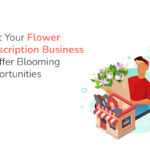
SaaS and Subscription-Based Startups are More Prone to Business Risks, Learn How
GenZ is also known as the startup generation as they are more enthusiastic and eager to set their targets with startups that would not only fertilize their fortune but also enrich them with fame, skills, growth, and freedom.
Today, startups produce more jobs than traditional corporate businesses. According to SBA, startups contribute four to five million jobs in the US market, alone.
The expanding subscription economy is a flourishing outcome of successful startup mushrooming. The subscription business model can be called the startup child raised by innovative ideas, developed by hearty hard work, and nurtured with robust risk management.
IT and communication industries played a major role in growing the subscription economy and fueling the trend to switch business to a stable, reliable, and predictable recurring revenue model. Digital media, esports, streaming services, etc. are a few of the examples of subscription based-startups that fly high.
SaaS is also one of the most promising industries in the subscription economy. According to Gartner, all new software entrants and 80% of historical vendors are offering subscription-based business models. The PayPers reports a 30 to 50 percent growth of the subscription billing vendor.
The excellence in growth and success of startups is an outcome of the calculative business moves with out-of-the-box risk assessment.
Subscription-Based Startups and the Significance of Risk Management
Entering into the realm of a startup with bigger dreams and fewer resources is quite a risk than becoming a part of the corporate system with fewer responsibilities and more perks like the reliable and stable source of income, salary benefits, and, above all, the work-life balance.
Still, individuals land themselves into the hot waters of risks and strive to succeed in achieving what they have aimed for. Some thrive because they know the value of assessing risks and taking calculative moves at right time and in the right place, whereas most won’t.
CBinsight suggests that almost 90 percent of the startups fail due to the following key reasons:
- 45 percent fail because they misinterpret market demand.
- 29 percent fail because they run out of personal finances and other resources of funding.
- And, 19 percent lost their aims to weak teams and strong competitions.
Some other very common reasons for startup failures include;
- Pricing/cost issues
- User-unfriendly products
- Poor marketing
- Product mistiming
All the above-mentioned stats, facts, and figures show how the miscalculation of business moves, under-or over-estimation of competition, and misinterpretation of the market can drown a great idea in no time.
Startups must know and assess the risk beforehand to avoid serious losses that can cease their journey in the beginning, only.
Enterprises and large organizations have extensive risk management teams that look after the interest of the company to prevent them from financial losses or repute damages.
However, small businesses and startups have to manage business risks with limited and available resources while staying in the means.
Businesses with recurring billing models are more susceptible to operational, compliance, and financial risks. Though subscription-based startups should focus their resources to manage not only these risks but all the risks as they rely on recurring payments that essentially depend on customer retention.
More customer retention means less churn that ultimately causes more recurring revenue streaming.
Let’s learn what are the main risks that subscription businesses can encounter and how these can be assessed, managed, and prevented with the right strategies.
Different Types of Business Risks and Subscription-Based Startups
Every space of the business is indeed a risk zone. Subscription and SaaS startups must cover all the five main areas of the business risks to devise a comprehensive and sophisticated risk management strategy.
These include:
-
Strategic Risks
Every idea has its shell life. All the products or services without improving or inclining themselves with the surging demands of the times cannot survive. Businesses have to upgrade their products, services, and business plans according to market trends and consumers’ demands. Failing to do so makes the businesses less effective and, eventually, replaces them with the small-scale and bussing business idea.
Strategic risks refer to the challenges of business development that a startup has to face while aiming for more growth and revenue.
The strategic risks can be occurred due to any of the following reasons:
- Technological Changes
- New Competitions
- Customer Preferences Shift
- Raw-Material Costs Surge
- Geo-Political or Environmental Changes
The outbreak of the coronavirus is an example of strategic risk. After the pandemic, most businesses, from fashion to automobile, have suffered shutdowns, revenue losses, and shifts in customer preferences that made their business model and product irrelevant.
The business assessed the vulnerability of the market and a major shift in switching the business model from a one-time payment to a recurring revenue model has been observed. It was an appropriate case of risk management.
-
Compliance Risks
Businesses are not independent entities. Every business is a part of the body and complies with the rules and regulations of not only the body but the region where it belongs.
They have to follow all the laws and rulings of the country or state all the time. Failing to do can incur heavy fines, accounts freeze, and many other complications.
These rules are not fixed, they can change with time, reasons, or government.
Since the businesses have gone online, they are required to comply more when they extend their service area or product lines. Digital sales and marketing further escalated the compliance risks with the tracking cookies, online payments, personal data security, digital intellectual rights, etc.
The compliance risks can be triggered into the strategic risks. Cloud, retail, and services businesses based on subscription billing are most disposed of the compliance risks.
To prevent and manage compliance risks, startups must keep themselves updated with the law promulgating processes, bodies, and individuals. Keeping a focused eye on the factors that can affect law-making can help startups to alter their operations and management in accordance with the laws.
-
Operational Risks
Not all risks are incurred from outside. Your company, people, system, or customers can be a trigger of operational risks. Operational risks include any unexpected and sudden failure of any operation that can cost money, manpower, or resources.
From technical issues to unproductive team and management failure to poor customer service, all are examples of operational risks that can halt the business processing at any functional point.
Some of the common operational risks to the business processes are:
- Execution Failure
- Delivery Failure
- External Fraud
- Internal Fraud
- Business and Product Practices
- Client Practices
- Employment Practices
- Workplace Security
- System Failures
- Damage to Physical or Digital Assets
Often, SaaS may incur the failure or delay in the recurring billing and payment processing management. Technical glitches at the end of the bank causing payment decline can lead to involuntary churn. Similarly, the lag due to maintenance and upgrade of the SaaS or any other cloud platform can irritate the customer and ends up in subscription cancelation. Fro unfriendly interface to insufficient payment options at the checkout, all are the operational risks for SaaS and subscription businesses and can disrupt customer retention resulting in opportunity or revenue loss.
-
Financial Risks
Investopedia defines financial risk as the possibility of losing capital on an investment or business venture.
Financial risk misassessment is one of the major reasons for startups’ failure. SaaS and businesses based on the subscription model need to focus on stabilizing their finances streaming to continue the recurring revenue.
Different factors constitute the financial risks which include the government’s inability to control monetary policy or the organization’s failure to undertake the financial burden. Changing interest rates, the value of the currency, or inappropriate financial decisions taken by individuals or bodies can be a risk to a SaaS company or a subscription-based eCommerce venture.
Financial risks for the SaaS or subscription businesses can mainly be classified into:
- Foreign Investment Risks
- Credit Risks
- Liquidity Risks
- Asset-backed Risks
- Equity Risks
- Currency Risks
-
Reputational Risks
Any kind of risk can inflict reputational risk to a business.
Reputational risk can be defined as a threat or danger to the standing of a business or entity. Directly or indirectly—it can be occurred either way. The company itself be a risk to the business or other stakeholders indirectly damage the repute of a business or industry.
Global Risk Management Survey identifies the following most common reputational risk to the businesses include;
- Damage to reputation/brand
- Economic slowdown/slow recovery
- Regulatory/legislative changes
- Increasing competition
- Failure to act or retain top talent
- Failure to innovate/meet customer needs
- Business interruption
- Third-party liability
- Computer crime/hacking/viruses/malicious codes
- Property damage
For SaaS and subscription businesses, damage to the reputation means lesser customer engagement that essentially disrupts the recurring revenue growth. It ultimately transforms into economical risks.










